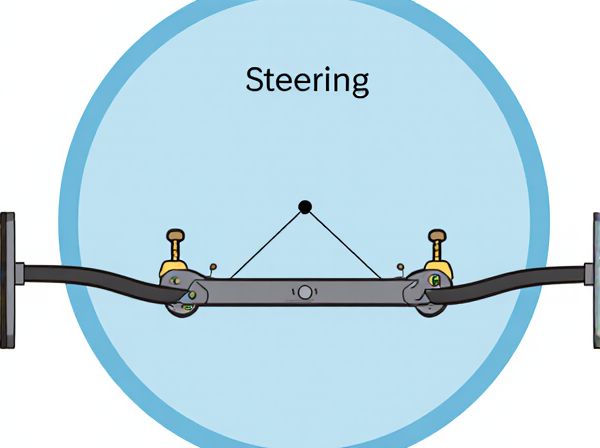
Photo illustration: Parallelogram Steering vs Rack Steering
Parallelogram steering systems utilize a series of linkages shaped like a parallelogram to transfer the motion from the steering wheel to the wheels, providing robust and reliable control for heavier vehicles. Rack steering, common in modern cars, employs a simpler mechanism with a toothed rack and pinion that converts rotational motion into linear movement, offering more precise steering and better road feel. Your choice between the two depends on the vehicle type and desired steering responsiveness, with rack steering typically favored for passenger cars and parallelogram systems used in trucks or older models.
Table of Comparison
| Feature | Parallelogram Steering | Rack Steering |
|---|---|---|
| Mechanism | Uses a series of linkages forming a parallelogram to steer wheels | Direct rack and pinion gear mechanism for steering control |
| Steering Precision | Less precise due to multiple linkages | High precision and responsiveness |
| Complexity | More complex with multiple components | Simpler design with fewer parts |
| Durability | Good durability but prone to wear in linkages | Durable with less maintenance required |
| Common Usage | Older vehicles, trucks, heavy-duty cars | Modern passenger cars and sports vehicles |
| Cost | Generally lower initial cost | Higher initial cost, better long-term value |
Introduction to Steering Systems
Steering systems in vehicles primarily include parallelogram steering and rack steering, both crucial for controlling wheel direction. Parallelogram steering uses a series of arms and linkages forming a parallelogram shape, providing stability and precise maneuvering. Rack steering features a direct rack and pinion mechanism, offering quicker response and reduced component complexity for improved handling.
What is Parallelogram Steering?
Parallelogram steering is a mechanical linkage system used in vehicles to connect the steering wheel to the front wheels, enabling directional control with precise movement replication. It consists of components like the pitman arm, idler arm, center link, and tie rods arranged to form a parallelogram shape, ensuring synchronized wheel alignment and smooth steering response. Compared to rack steering, parallelogram steering is commonly found in heavier trucks and off-road vehicles due to its durability and ability to handle larger loads.
What is Rack and Pinion Steering?
Rack and pinion steering is a mechanical system that converts the rotational motion of the steering wheel into the linear motion needed to turn the wheels, utilizing a circular gear (pinion) engaging with a linear gear (rack). This setup offers precise control and quick response, making it common in modern passenger vehicles. Compared to parallelogram steering, rack and pinion systems are more compact, lighter, and require less maintenance, enhancing overall driving experience and reliability.
Key Components of Parallelogram Steering
Parallelogram steering primarily consists of a steering wheel, steering column, pitman arm, idler arm, center link, and tie rods, all working together to convert rotational motion into lateral motion for precise wheel control. The pitman arm, attached to the steering box, transmits the steering input to the center link, while the idler arm supports the center link on the opposite side, maintaining alignment and stability. Tie rods connect the center link to the steering knuckles, ensuring accurate and synchronized wheel turning critical for vehicle handling.
Key Components of Rack and Pinion Steering
Rack and pinion steering consists of key components including a circular gear called the pinion that meshes with a linear gear, the rack. This system translates the rotational motion of the steering wheel into the linear motion needed to turn the vehicle's wheels precisely. Its compact design provides direct steering feedback and is commonly used in modern passenger cars for responsive handling.
Performance Differences: Parallelogram vs Rack Steering
Parallelogram steering systems offer more precise control with reduced play, enhancing vehicle handling at varied speeds, whereas rack steering provides quicker response and simpler mechanics for improved performance in tight turns. The rigid linkage in parallelogram steering ensures consistent steering geometry, beneficial for larger vehicles requiring stability, while rack steering's direct linear movement optimizes feedback and reduces steering effort. Performance differences between the two systems impact vehicle agility, steering accuracy, and driver confidence, making each suitable for different automotive applications.
Advantages of Parallelogram Steering
Parallelogram steering offers superior durability and smoother operation due to its robust linkage design, which minimizes wear and tear compared to rack steering systems. This mechanism provides enhanced feedback and control, especially at lower speeds, making it ideal for vehicles requiring precise maneuverability. Its simpler construction also facilitates easier maintenance and repair, contributing to lower long-term costs.
Advantages of Rack and Pinion Steering
Rack and pinion steering offers precise control and a more direct steering response, enhancing vehicle handling and driver feedback. This system is lighter and simpler in design compared to parallelogram steering, contributing to reduced maintenance costs and improved durability. The compactness of rack and pinion mechanisms also allows for better integration in modern car designs, optimizing space without compromising performance.
Applications and Vehicle Types
Parallelogram steering systems are commonly used in older or heavy-duty vehicles such as trucks and off-road SUVs due to their simple design and durability in rugged conditions. Rack steering is prevalent in modern passenger cars and light vehicles, offering precise control and improved handling for urban and highway driving. Each system's application aligns with vehicle type requirements, where parallelogram steering emphasizes robustness and rack steering prioritizes responsiveness and compact design.
Choosing the Best Steering System for Your Vehicle
Parallelogram steering offers a robust and simpler design ideal for trucks and heavy-duty vehicles, providing precise wheel alignment and durability under tough conditions. Rack steering systems excel with responsive handling and reduced steering effort, making them preferred for passenger cars and performance vehicles seeking agility and smooth operation. Selecting the best steering system depends on vehicle type, driving purpose, and maintenance considerations to balance control, comfort, and reliability.
 caratoz.com
caratoz.com